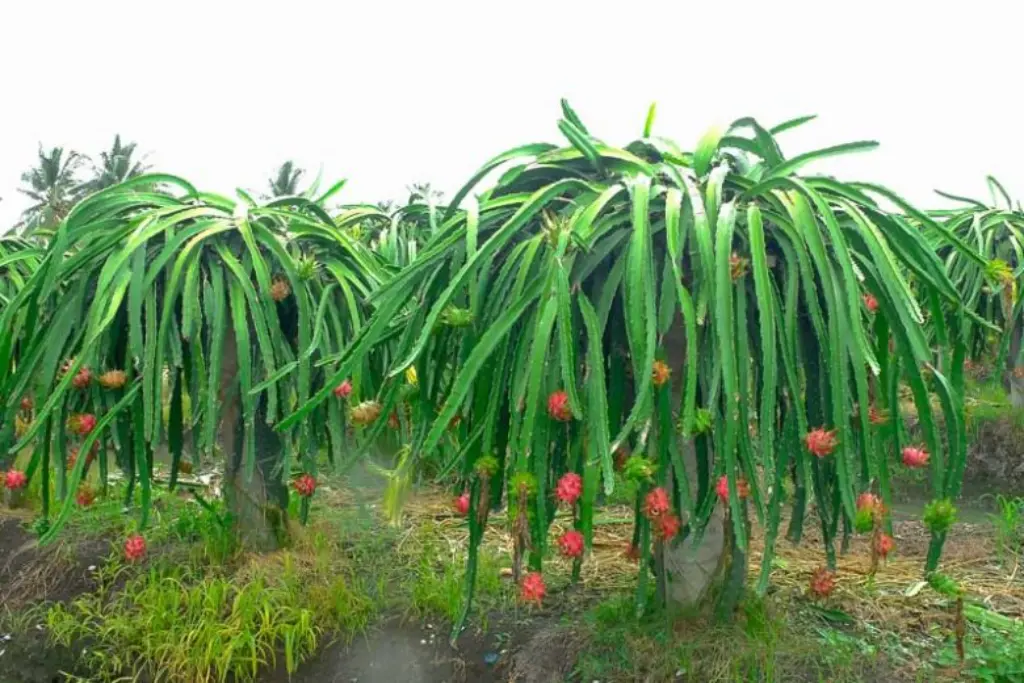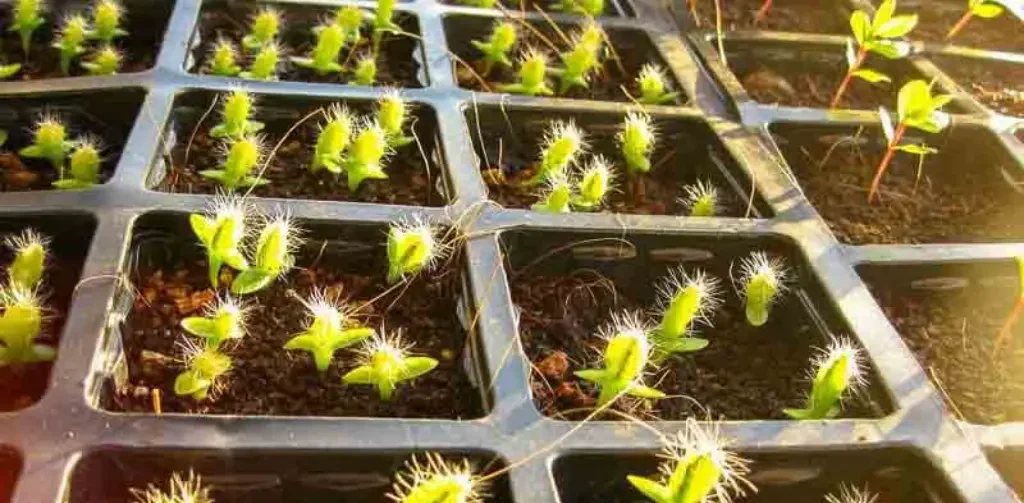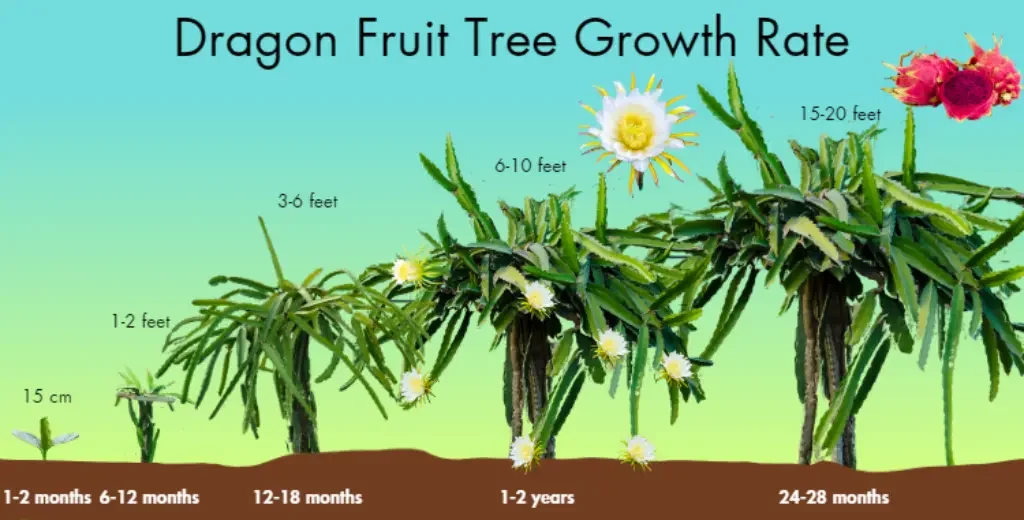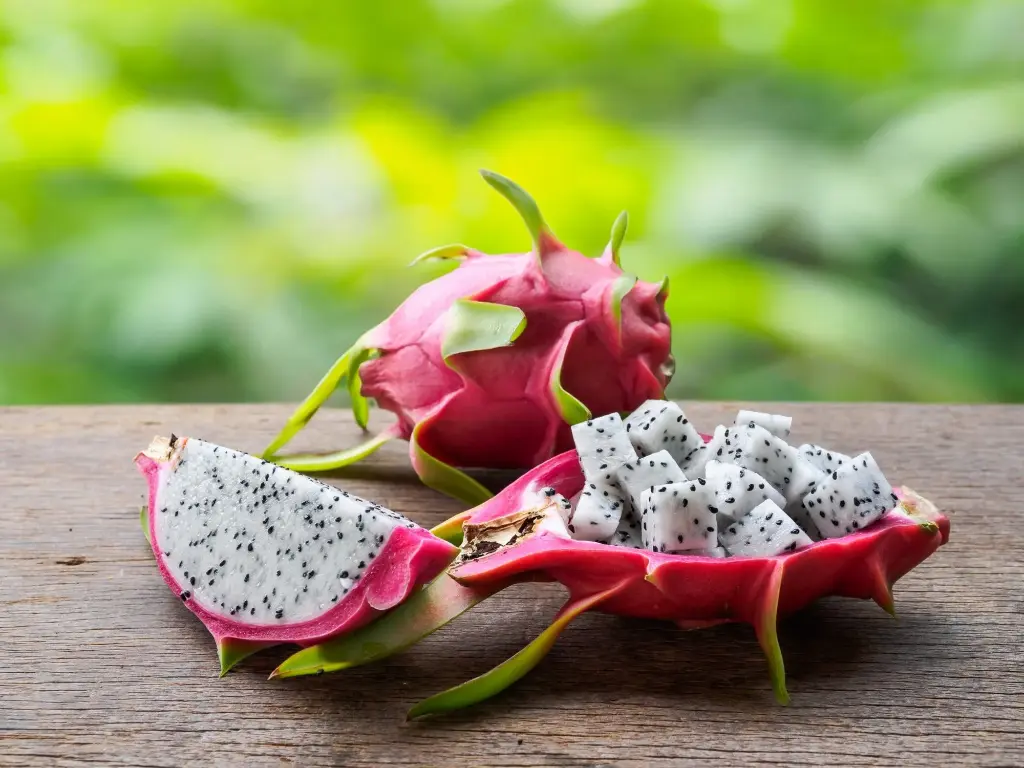Dragon fruit, also known as pitaya, is a stunning and exotic fruit that’s not only a visual delight but also a nutritional powerhouse.
This tropical fruit, which grows on a cactus species, is becoming increasingly popular among home gardeners due to its unique appearance, delicious taste, and relatively easy care requirements. In this comprehensive guide, we will delve into every aspect of growing dragon fruit, from planting to harvest, ensuring that you have all the knowledge needed to cultivate this fascinating fruit successfully.
Introduction to Dragon Fruit

What is Dragon Fruit?
Dragon fruit comes from several different cactus species, primarily from the genus Hylocereus and Selenicereus. The most common varieties have vibrant pink or yellow skin with white, red, or purple flesh speckled with tiny black seeds. Dragon fruit is known for its sweet, mildly tangy flavor and crunchy texture.
Types of Dragon Fruit
There are three main types of dragon fruit, distinguished by their skin and flesh color:
- Hylocereus undatus: Pink skin with white flesh (most common variety).
- Hylocereus costaricensis: Pink skin with red or purple flesh.
- Hylocereus megalanthus: Yellow skin with white flesh.
Each variety has its own unique taste and growing requirements, but all follow similar cultivation practices.
Preparing to Grow Dragon Fruit
Climate Requirements
Dragon fruit thrives in tropical and subtropical climates. Ideal conditions include:
- Temperature: Between 65°F and 85°F (18°C to 29°C). Dragon fruit can tolerate short periods of cold (down to 32°F or 0°C) but is not frost-resistant.
- Humidity: Moderate to high humidity levels are beneficial.
- Sunlight: Requires full sun to partial shade. Ensure at least 6-8 hours of sunlight per day for optimal growth.
Soil Requirements
Dragon fruit prefers well-draining soil with the following characteristics:
- pH Level: Slightly acidic to neutral (pH 6-7).
- Composition: Sandy or loamy soil enriched with organic matter.
- Drainage: Good drainage is crucial to prevent root rot. Raised beds or mounds can be beneficial in areas with heavy rainfall.
Choosing the Right Location
Select a location that provides ample sunlight, good air circulation, and protection from strong winds. Dragon fruit cacti can grow quite large, so ensure there is enough space for the plant to expand.
Planting Dragon Fruit
Propagation Methods

Dragon fruit can be propagated through seeds or cuttings. Cuttings are the preferred method as they produce fruit faster.
Propagating from Cuttings
- Selecting Cuttings: Choose healthy, mature stems from an existing dragon fruit plant. Each cutting should be about 12-18 inches long.
- Preparing Cuttings: Allow the cuttings to dry in a shaded area for 5-7 days. This helps prevent rot when planting.
- Planting Cuttings: Plant the cuttings about 2-3 inches deep in well-draining soil. Space them about 24-36 inches apart.
- Watering: Water the cuttings lightly after planting. Keep the soil moist but not waterlogged.
Propagating from Seeds
- Extracting Seeds: Scoop out the flesh of a ripe dragon fruit and separate the seeds.
- Preparing Seeds: Rinse the seeds and allow them to dry.
- Planting Seeds: Sow the seeds in a seed-starting mix, lightly covering them with soil.
- Germination: Keep the soil moist and place the container in a warm, sunny location. Seeds will germinate in 1-4 weeks.
- Transplanting: Once seedlings are 3-4 inches tall, transplant them to their permanent location.
Supporting Structures
Dragon fruit plants are climbing cacti and require support to grow vertically. Common support structures include:
- Trellises: A sturdy trellis or fence can provide adequate support.
- Posts: Concrete or wooden posts with crossbars can help manage the weight of the plant.
- Wires: Using wires to train the plant can be effective for large-scale plantings.
Seasonal Care Guide

Here’s a handy seasonal guide to help you manage your dragon fruit care throughout the year:
| Month | Activity | Description |
|---|---|---|
| January | Planting | In warm climates, plant new cuttings or seeds. |
| February | Planting | Continue planting and ensure young plants are protected. |
| March | Fertilizing | Apply balanced fertilizer as new growth starts. |
| April | Watering | Increase watering as the weather warms up. |
| May | Pruning | Prune dead or weak stems to encourage new growth. |
| June | Flowering | Watch for the first flowers to appear. |
| July | Pollination | Assist in pollination if necessary for fruit set. |
| August | Harvesting | Harvest ripe fruit as they mature. |
| September | Pruning | Prune back after harvest to maintain shape. |
| October | Pest Control | Monitor and manage any pest issues. |
| November | Mulching | Add mulch to protect roots from cooling temperatures. |
| December | Dormancy | Reduce watering as plants enter a dormant phase. |
Ongoing Care and Maintenance
Watering
- Frequency: Water dragon fruit plants regularly, especially during the growing and fruiting seasons. Reduce watering in winter.
- Method: Use drip irrigation or soaker hoses to ensure deep watering without wetting the foliage.
- Soil Moisture: Keep the soil consistently moist but not waterlogged.
Fertilizing
Dragon fruit plants benefit from regular feeding:
- Balanced Fertilizer: Apply a balanced fertilizer (10-10-10) every 2 months during the growing season.
- Compost: Incorporate compost or well-rotted manure into the soil to enhance fertility.
- Micronutrients: Provide additional micronutrients such as iron and magnesium if the plant shows signs of deficiency (yellowing leaves).
Pruning
- Timing: Prune dragon fruit plants in late winter or early spring before new growth starts.
- Technique: Remove dead, diseased, or weak stems. Thin out overcrowded areas to improve air circulation.
- Maintenance: Regularly trim back excessive growth to maintain the desired shape and size.
Pest and Disease Management
- Pests: Common pests include ants, aphids, and mealybugs. Use organic insecticides or introduce beneficial insects to control infestations.
- Diseases: Dragon fruit is generally disease-resistant but can be affected by fungal infections. Ensure good air circulation and avoid overhead watering to prevent fungal issues.
Pollination
- Self-Pollinating Varieties: Some dragon fruit varieties are self-pollinating, while others require cross-pollination.
- Hand Pollination: If natural pollinators are scarce, use a soft brush to transfer pollen from one flower to another.
Harvesting Dragon Fruit
Identifying Ripe Fruit
- Color: The skin of the fruit will change color, becoming bright and vibrant.
- Size: Fruit should reach its full size before harvesting.
- Touch: Ripe fruit will have a slight give when gently squeezed.
Harvesting Techniques
- Cutting: Use a sharp knife or pruning shears to cut the fruit from the plant, leaving a small section of stem attached.
- Handling: Handle the fruit carefully to avoid bruising.
Post-Harvest Care
- Storage: Store harvested fruit in a cool, dry place. Dragon fruit can be refrigerated for up to 2 weeks.
- Uses: Enjoy dragon fruit fresh, in smoothies, salads, or desserts. It can also be used in jams and jellies.

Growing dragon fruit can be a rewarding experience, offering both aesthetic appeal and delicious fruit. By understanding the plant’s requirements and following this comprehensive guide, you can successfully cultivate dragon fruit in your garden. Remember to provide the right climate, soil, and support, and follow the seasonal care guide to ensure healthy growth and abundant harvests.
Whether you are a novice gardener or an experienced horticulturist, dragon fruit is a fascinating and fruitful addition to any garden. Happy growing!



